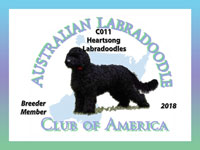About The Australian Labradoodle
Not A Lab-Poodle Mix
While often thought of as a cross between a Labrador and a Poodle, The Australian Labradoodle is far more complex than a Labrador - Poodle mix and has a far richer history. First bred in the 1970s, a breeder crossed a Labrador and a Poodle to fulfill the request of a blind woman who needed a service dog and whose husband suffered from allergies to dog dander. While the breeding was successful, the breeder abandoned the project due to his inability to produce consistent results. Australian Breeders became fascinated with the idea of a mixed breed given the name "labradoodle".
The Australian breeders continued to develop the breed with varyng success. Life long breeders have now revealed their "secret recipe" and identified other breeds used in foundation stock to produce the wonderful companion dog that we know today as the Australian Labradoodle. ( Please refer to Breed Standard for a complete listing of the parent breeds.) Australian Breeders had mixed results with temperament and coats with early crosses. Various breeds were brought in to specifically correct certain aspects. As with most breeds, it takes far more parent breeds than two to create desirable and consistent results. The Australian Labradoodle has been bred by careful selection and research for health, coat and temperament for more than 15 years.
A Family Companion
The Australian Labradoodle is bred to be a family companion and a therapy assistant dog. Australian breeders have carefully avoided guarding, hunting, and herding lines. The result is very intelligent, easily trained, and low to non-shedding dog. This is a dog that may go to a hospital, psychiatric unit, or children's unit and not leave the coat behind and will behave like a well -bred Labrador! A well-bred Australian Labradoodle should be quite athletic when out and about and settle well when in the home. They thrive on companionship, but do not always demand attention. They love intellectual stimulation, but are not hard driven for action. They should be amazingly easy to train and people will comment on your Australian Labradoodle and its training. Our Silk just passed her therapy dog certification without any training. The leader was totally amazed at her eye contact and intelligence. She has had no formal obedience training.
This is the dog that we have fallen in love with and it has captured our fantasy and imagination! We want to protect and develop this wonderful breed that is famous for its intelligence, sense of humor, easy to train attitude, and joyous nature. We have chosen to work with the Labradoodle Association of Australia (LAA) and the Australian Labradoodle of Club America (ALCA) toward the goal of carefully developing this unique dog into a recognized breed of its own in Australia and in the United States. We hope to protect and care for this breed for many generations to enjoy. We hope to forever separate the Australian Labradoodle from the Labrador-Poodle mix, which has gained popularity and is often confused with the Australian Labradoodle. The ALCA and LAA grading scheme and pedigree history help to ensure that "multigenerational" means fully researched, documented, and conforms with the ALCA and LAA breeding standards.
We hope that you will do your research when looking for a qualified breeder. We support the ethics of ALCA and the LAA, which advocates responsible ownership and responsible breeding. We wish you a very happy doodling experience!
Australian Labradoodle Sizes and Coat Types
There are three sizes of Australian Labradoodle. All sizes are measured from shoulder to ground. Weights vary and sometimes the actual size of the dog is better understood in terms of pounds vs. inches.
- Minature: 14 inches to 16 inches
- Medium: 17 to 19 inches
- Standard: 21 to 23 inches
There are three coat types:
- Wool coat: Non-shedding, very coarse, yet different from a poodle-wool. Should be single coat and curly or spiraling. A definite course texture which may be felt. Desirable for breeding and allergies/asthma. Easily maintained by 3 to 4 puppy clippings per year.
- Fleece coat: Low to non-shedding, very silky in texture and easy to maintain, especially if wavy or lighter in curl.
- Hair: Least desirable because it is likely to shed. This is a "throw back" coat and should be bred away from. Easy to maintain, though shedding is possible. This coat is very much like that of a regular dog.
Breed Standard
The official breed standard is maintained by the Australian Labradoodle Club of America and defines the breeding goals and criteria that member breeders follow. The standard includes detailed descriptions of temperment, size, coat types, and colors.
